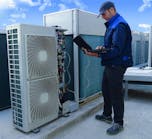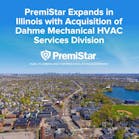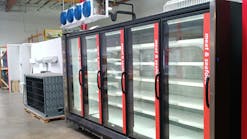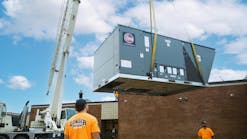by Mark Quebedeaux, P.E.
You may deal with moisture and humidity in your part of the country, but I’ve probably got you beat when it comes to tough problems. I live in Southern Louisiana. As a result, I’m often called upon to evaluate buildings with indoor air quality (IAQ) problems. Whether it’s mold growth on walls, and ceilings or condensation on the walls and floors, the symptoms always point to the same diagnosis: excessive moisture.
High relative humidity (60% and above) is a leading cause of the dreaded sick building syndrome because it allows mold and mildew to grow uncontrollably.
Although there are a wide variety of ways to control moisture, one means that has been successful in the buildings I service in this tough Southern environment is the use of chilled water constant volume and multi-zone air handlers with reheat.
The Building Envelope:
A Starting Point
When diagnosing and solving moisture problems, start by inspecting the building envelope for signs of visible moisture. Leaky roofs, water-damaged walls, leaky windows, and unsealed holes around conduits and piping through exterior walls all allow moisture to enter the building envelope. These problems should be addressed as soon as practical to prevent further damage.
Most commercial buildings should be positively pressurized up to 110 in. w.c. to minimize infiltration. Buildings that are negatively pressurized are prime candidates for moisture problems. This is particularly a problem when outdoor air intakes have been closed, thereby eliminating the make- up air for the building exhaust system.
The HVAC System
When evaluating HVAC systems, I begin by getting a general idea of how the system(s) are set up, i.e. single zone, multi-zone, preheat, reheat, the spaces served by the system, how many people and what type of equipment are in the spaces. This information will be helpful later on when determining the cooling and heating loads.
Up-to-date drawings of the building are a good source of information. If you can obtain the drawings, review and check them against the building to verify the spaces shown on the drawings actually match the current building floor plan.
Next, take a good look at the entire mechanical system, the mechanical room(s),
and the air handling equipment. Determine what types of air handler(s) are being used to provide cooling to the various zones of the building.
I always try to get all nameplate data because it may help obtain important factory information such as size, capacity, entering and leaving chilled water temperatures, entering and leaving air temperatures, etc. This information is especially helpful when drawings of the system aren’t available.
Other things to look for are chilled water valve arrangement (three-way or two-way), reheat coil arrangement, capacity and type (electric, steam, or hot water).
A thorough cooling load calculation for the building in question can reveal much. First and foremost, it allows you to evaluate the load for the building as it is currently being used, not as it may have been used at one time.
Calculations confirm if the existing system tonnage is under, over, or just the right capacity to meet the building’s requirements. The building’s load profile can also be analyzed to determine when the part load conditions occur. As illustrated in Figure 1, the peak sensible load and the peak latent load don’t occur at the same time.
The cooling load output data should provide:
- required air flow
- chilled water flow rate
- entering/leaving chilled water temperatures
- entering air/leaving air dry bulb and wet bulb temperatures
- volume of outdoor air, room temperature, and relative humidity.
Typically, room temperature, relative humidity, and outdoor air quantity are input values that are predetermined prior to doing the load calculations. The standard ASHRAE design temperature is 75F and 50% relative humidity, although lower space temperatures are preferred. The standard outdoor air quantities should be based on local codes or ASHRAE standard 62.
Air Handlers & Cooling Coils
With the air side system information gathered and confirmed and all the calculations done, we can now figure out what’s really happening with the air side systems for the suspect building.
Evaluate the overall condition of the air handlers. Start by checking the drain pans and condensate drain lines. It’s not uncommon to find a unit holding water in the drain pan because of an improperly trapped condensate line or a plugged condensate pan. Standing water inside the air handler will only serve to rehydrate the air as it passes over the coils, especially when there is no chilled water flowing through them. Sometimes, the drain pans are rotten, and the unit casing serves as a retention pond for the condensate.
These conditions are great contributors to building moisture and microbial growth. The best solution is to properly pipe the condensate drain and repair or replace the drain pan, assuming it can be replaced. There are times when nothing short of replacing the air handler will do.
Assuming there are no drain problems, and the unit is in good condition, the next step is to check the airflow across the cooling coil. Air moving too fast through a cooling coil can cause “carryover.” This occurs when air flowing through the cooling coil at high velocities carries condensate off of the coil surface and traps it in the leaving air stream, carrying it down the duct system.
Carryover typically becomes a problem at air face velocities between 500 and 600 ft./min., depending on the fin type, fin spacing, and coil cleanliness. My general rule of thumb is to stay between 500 to 550 ft./min.
A quick check can be done to identify if carryover is likely, by taking the unit rated air flow in cfm and dividing it by the coil area (sq.ft.) to get the air velocity (ft./min.).
If carryover is suspected, and there’s significant mold infestation, it’s probably a good idea to open the duct work on the supply air side and look at the lining within several feet of the supply air outlet. If carryover is occurring, the liner will, more than likely, be covered with mold and will be deteriorated, depending on the age of the system.
Assuming the air handlers are properly sized for the load, this problem can be readily corrected by adjusting or replacing the pulleys to achieve proper airflow and velocity through the cooling coil.
Adjusting the airflow to the desired rate will prevent carryover and increase the moisture removal ability of the cooling coil because of the increased heat transfer.
The mold-infested duct immediately down stream of the supply air fan should be either cleaned and coated with antimicrobial spray or replaced with sheet metal duct externally insulated with duct wrap. I recommend the latter.
Another concern is outdoor air entry into the air handler. It’s common to find air handler rooms set up as plenums when space is limited. The room acts as a general plenum space that draws return air from the spaces and draws outdoor air directly into the mechanical room from an outdoor louver.
When outdoor air is drawn directly from an exterior louver with little or no attached duct work and, often, no damper, there’s absolutely no way of properly controlling the amount of outdoor air being drawn into the mechanical room.
Even when a damper is placed on the downstream side of the louver, inside the mechanical room, and adjusted to provide a fixed amount of outdoor air, chances are that more than the required amount of outdoor air will enter the room and the air handler.
This occurs because the air will take the path of least pressure drop or resistance. The return air pressure drop is normally much higher than the louver and damper combination. Therefore, the air handler fan will draw more outdoor air than is needed.
This situation can be corrected by one of the following means. The first and simplest is to duct the outdoor air to the unit if possible, preferably to a mixing box, which can be factory- or field- made. The supplemental duct and damper will add resistance to the outdoor air portion of the system, making it easier to balance the return air and the outdoor air.
If it’s not possible to run any additional ductwork in the room, a second approach would be to pretreat the outdoor air to either return air conditions of 75F or supply air conditions of 55F and let the air enter the room at the fresh air louver.
Work with your local equipment vendor to get the proper selection on the pre-treat system. This ensures the air leaving the pretreat cooling coil is at the right conditions so as not to impose any additional or unnecessary cooling or heating loads on the air handler.
It’s equally important to check the louver size. Undersized louvers can create a similar effect as that of coil carryover. A louver that’s too small will increase air velocity and can induce rain droplets into the air stream and into the mechanical room or outdoor air duct.
When it comes to chilled water, cooling coils I prefer to use a minimum of a 4-row coil for general cooling where there’s a small outdoor air requirement. When large quantities of outdoor air are required, I usually move up to a 6- or 8-row cooling coil to wring out the moisture. However, as for using two position chilled water control valves, they don’t allow for precise control of the leaving air temperature because the valve doesn’t modulate. Two position valves are either fully opened or closed.
So, what should the leaving air temperature really be? For most commercial applications, I design systems to achieve 55F leaving air. I want to get the air as close as possible to the cooling coils dew point temperature so that the coil is always wet or dehumidifying.
However, when the building load drops and the outdoor air temperature begins to approach that of the indoor air temperature, 55F leaving air can quickly overcool the space, making it uncomfortable for the building occupants. The traditional remedy for preventing the overcooling of spaces is reheat.
Reheat Coils
Some systems are set up to have the heating coils inside the units and others have heating coils inside the ducts at each zone or space. For this reason, check these coils for cleanliness and operability. Although heating coils don’t contribute to moisture problems, not using them as designed surely can.
The heating coil is an important part of the dehumidification process. In order to dehumidify the air, the cooling coil has to be active. However, during low load conditions, the space can be overcooled. During low load conditions, the reheat coil is used to reheat the leaving air as required to maintain a comfortable space temperature (Figure 2 shows the dehumidification process with reheat).
It’s important to verify that the existing heaters are sized properly for the load. In the case of hot water reheat coils, they’re often operating at water temperature set too low (140F degrees and lower). In most applications, the industry standard for hot water coils is 180F entering water and 160F leaving water. If the heating coil is sized for these water temperatures, and the temperature is set lower than 180F, the capacity of the heating coil is greatly reduced.
System Operation and Control
When determining the source of humidity problems, it’s equally important to take a look at how the equipment is being operated and controlled. For example, a building can have high humidity problems even if the equipment capacity can handle the cooling loads with outdoor air.
In many cases, the problem is system operation. For example, someone decides to block off the fresh air ducts and disable the reheat system by simply shutting off the boiler. The rationale is: ”Shutting down the boiler system will save us lots of money.”
While there may be short-term savings on the gas bill, the cost of repairing a deteriorating building, and possibly replacing its contents, can be far more costly than the gas bill. Assuming everything is working properly, the problem can be corrected by restoring the system to its original operation.
Now let’s look at when the equipment is too large for the space. There are several reasons why cooling coils are sometimes larger than necessary.
The first and most obvious is the miscalculation of the actual load. Second, the building function may have changed, causing the load to decrease. For instance, former computer rooms may now be serving as office space. Third, the equipment may have been designed to operate at a 14F chilled water split instead of a 10F chilled water split.
The latter usually occurs when older chillers are replaced, and the replacing engineer/contractor assumes that the system operates at the typical 10F. In this condition, the air handlers are far oversized for the load. Chilled water valves will also stay closed longer, allowing outdoor air and building moisture to get out of control quickly. The only solution here is a total air and water balance to get the equipment as close to the original capacity as possible.
At times, however, the problem is a controls issue. Humidistats, thermostats, and control valves must work in the right sequence for the system to work properly. Calibrate control components such as thermostats and humidistats at least once per year, especially if they’re pneumatic.
In addition to the cooling coil, the next most important item is the control valve. For humidity control, nothing works like a true modulating valve. Two position valves are occasionally used because they’re very inexpensive, but don’t provide precise control.
In a typical control sequence, the thermostat (sensible heat device) controls the chilled water valve based on room temperature. As the space temperature approaches the thermostat set point, the chilled water valve is slowly closed off as the set point is reached.
The air handler will continue to pump return and outdoor air into the space, causing the leaving air temperature to rise. As the space heats up, the thermostat calls for the valve to open to provide cooling.
As the outdoor air temperature falls (approaching that of the indoor air temperature), the sensible load usually decreases and the call for cooling by the thermostat is less. However, this is usually the time when the latent load increases, especially outside the space, and causes the moisture level in the space to rise due to the untreated outdoor air.
When humidity rises above the humidistat’s set point, the humidistat will override the space thermostat, causing the chilled water valve to open, starting the dehumidification process. The reheat coils will energize as required to maintain room setpoint.
Air Balancing
Air balancing is often neglected because of budget constraints. However, an improperly balanced air system just doesn’t operate properly or efficiently. Similarly, it really does pay to get a system correctly balanced. The building occupants will be comfortable, the system will operate at its peak performance, and temperature and relative humidity will remain where they were designed to be.
Some Final Suggestions
Finally, I don’t advocate the use of reheat systems in new construction projects unless it’s absolutely necessary. However, in existing buildings where these types of systems are found, I do recommend operating the system as it was meant to be operated, even if the utility costs are high.
The cost of operating the system properly will be far less than having the building slowly be destroyed by moisture or facing a lawsuit because of sick building syndrome. In most cases, it’s not possible or economically viable to reconfigure existing systems with new technology. However, in those cases where new technology can be applied, it should be. The paybacks can be handsome.
Mark Quebedeaux is engineering and construction supervisor of Star Service, Inc. in Baton Rouge, LA. He may reached at 225/383-0306 or at [email protected].








